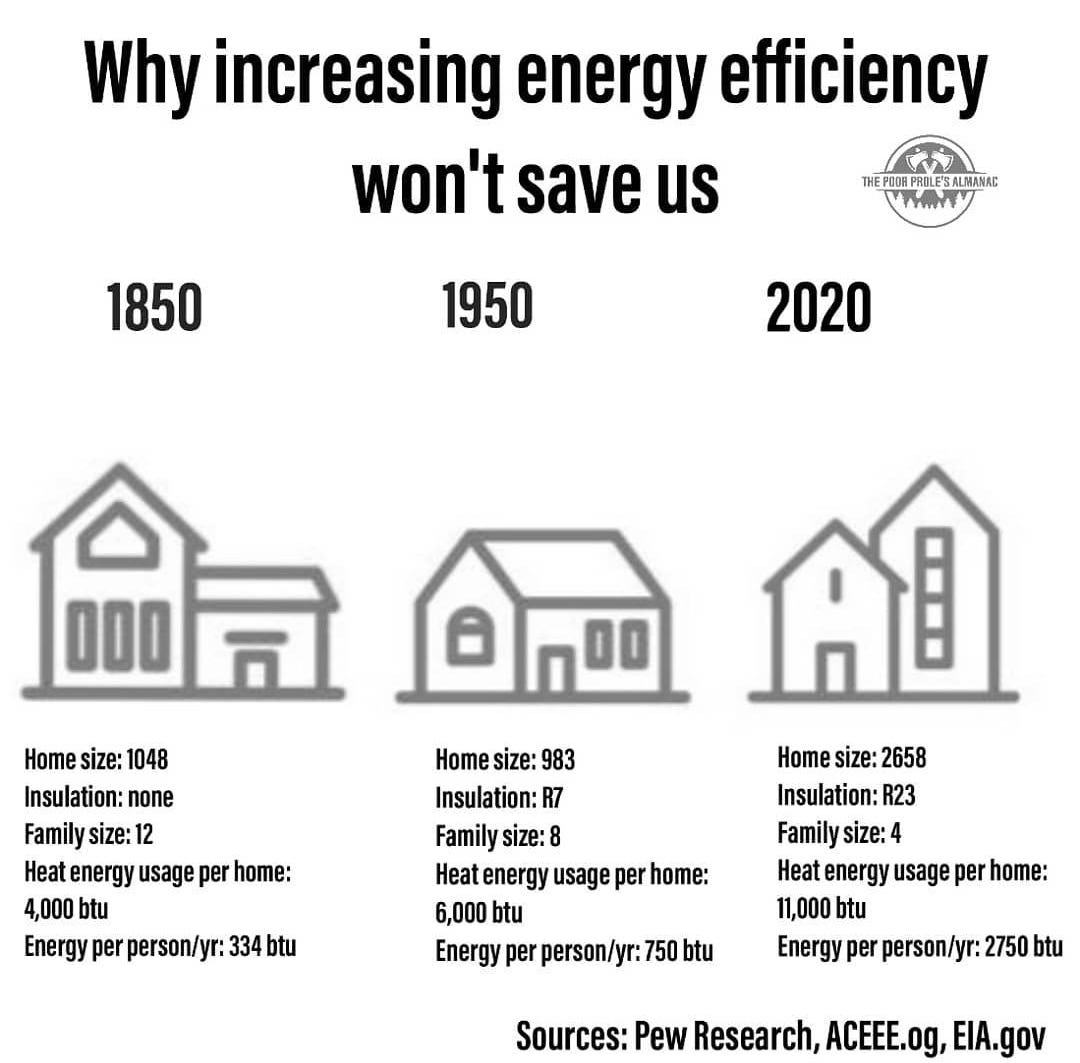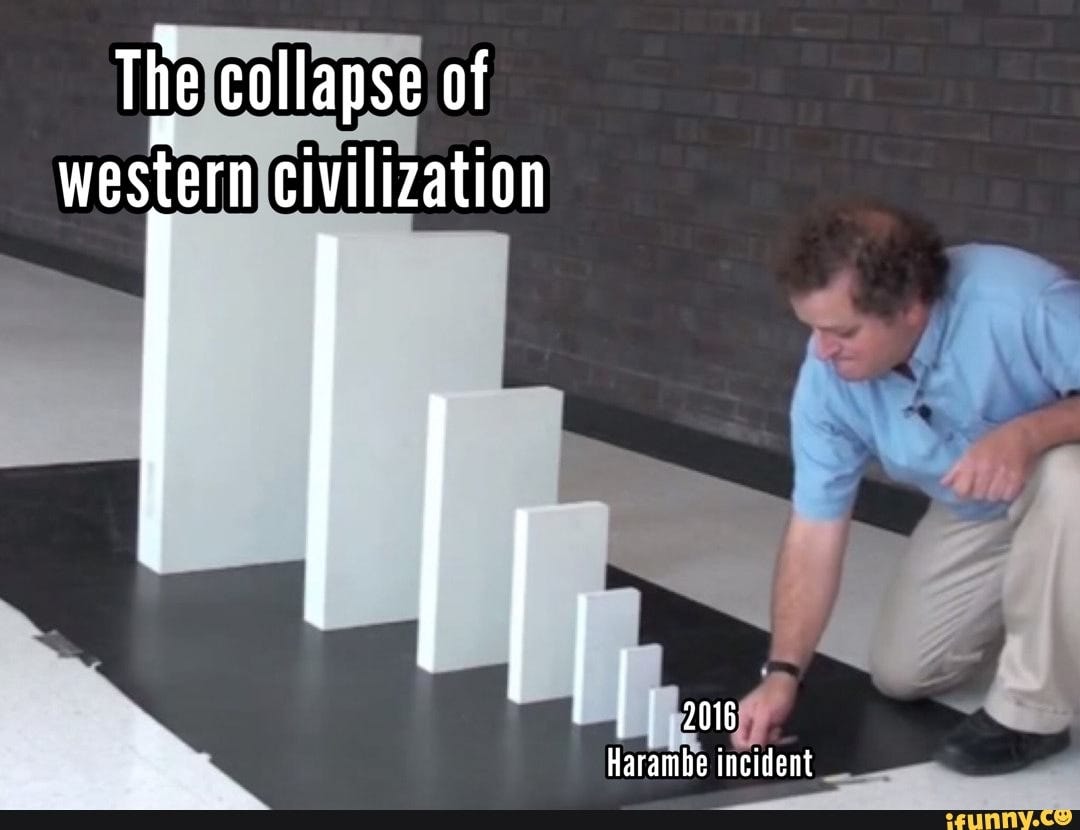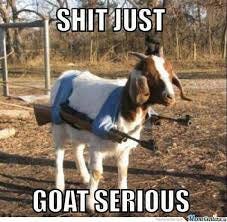From Entropy to Sustainability
Part two of Thriving in 2025: Climate Change, Complex Systems, and Sustainable Communities
Let’s circle back to some of my earlier thoughts. What about the green revolution— won’t that help? Well, not really. What these technologies do, effectively, is find ways to take energy from new sources, and it historically hasn’t changed the amount of energy being used. That’s not to say that there aren’t more ‘clean’ energies in terms of, say, breathable air, but the energy use itself is the problem. The problem is society has taken our energy efficiency improvements and, for example, with housing, used it to justify building houses that are 30% bigger than homes 50 years ago.1 Despite energy efficiency increases, our per-capita consumption continues to grow and grow, reinforcing that entropic system, and yeah-- you see how this goes.
A significant piece of why our consumption grows is EROEI, or energy return on energy invested. For example, you build a solar panel-- how much of the energy the solar panel creates needs to meet the costs to build the solar panel? Right now, a modern solar panel in 2014 had a return of about 10:1 ratio of energy.2 That could sound good or bad-- what context do we have for that? Well, let’s look at oil. Back in the early 1900s, the return on energy invested for oil was around 125:1.3 For every gallon of oil used to pumped oil and refine it, we got 125 gallons of useable energy. As we have already harvested the low-hanging fruit, that number has dropped dramatically and the EROEI on oil sits closer to 12:1, which is not much different yet still better than solar.4
For context, we currently have technologies, such as micro-hydro systems, with energy returns closer to 200:1, and that’s probably where we should be focusing our energies on if we want to create sustainable energy systems.5 The fact that they are smaller systems also is significant in terms of how I envision what our future looks like, and we can talk about a bit later.

Now we have something of a framework to understand the ecology of our planet, and we have evidence of what sustainable systems look like-- what exists out in nature, what exited before our species created vast networks of mercantilism and ultimately capitalism. Now there’s two features of complex systems that are significant in identifying the long-term successes or failures of complex systems-- and those two areas are cascading failures or dynamic networks of multiplicity. Cascading failures is a pretty simple concept; due to various coupling between components-- which we’ll touch on when we start talking about co-evolution, emergent development, and symbiotic relationships, what can happen is localized failures which can lead to large scale collapses of entire networks. Think about, say, when a lion is poached, and it is the only line for hundreds of miles. Without the predator, antelope and other species will grow in population, decimating the grazing fields which can only support a certain amount of antelope. This will dry out the soil, causing massive nutrient loss, and you can see where this is going.
The flip to this is having dynamic networks of multiplicity, in which local interactions between species and inter-area connections exist. In nature, this is usually the case. For the example above, while the loss of a lion would be significant, in a truly dynamic system, another carnivore would take its place, whether it be an increased hyena population, or some other species. This idea of dynamic networks of multiplicity, when those systems are complex systems, makes a lot of sense, right? It’s also nature’s model which inspired Murray Bookchin’s concept of communalism, which-- if you’re not familiar with-- is an anarchist theory that has been recently playing out in Rojava, a region in northeast Syria.6
Now, there are a few branches of ecology, and I want to bring them up and circle back to this conversation about the climate catastrophe. The first is physiological ecology, which is the relationship and interaction between an animal and its environment. More specifically, how organisms are adapted to their climate. The second I’d like to bring up is population ecology, which is the study of the relationship & interactions of animals within a specific population. Thirdly, there’s community ecology, which is focused on the relationships between different species-- whether they’re cooperative, competitive, etc. So, we’ve got 3 different relationships happening here; animal & nature, animal & same animal, and animal & other animal. 7
Complex Systems Science is Fundamentally about Relationships
With that framed up, let’s take a look at the symbiosis of these relationships, specifically called ecological symbiosis. When two animals interact, those relationships are either positive, negative or neutral, for each of those animals. Say a lion eats a zebra— that’s a plus for the lion, but a negative for the zebra. Duh. That’s called predation. The other positive and negative interaction is called parasitism. The difference between predation and parasitism is a parasite doesn’t kill, whereas a core function of a predator is killing another animal. The second a parasite kills its host, it has turned into a predator. Ticks are parasites, goats are parasites on weeds and other plant species, because it damages them, but doesn’t kill them, but the second a herd of goats destroys a field, that herd is now a grass predator. Now, if the goats killed the grass just by walking over it, and gained nothing from killing it, then the relationship is no longer that of predation, but amensalism.
And if we know our latin— and we do— amensalism is when one living thing kills another living thing with no measurable gain. Humans fit this category pretty well— we kill things all around us, like pillbugs, that have no discernable difference in the quality of our lives.
For you permaculturalists out there, which, if you are, this probably is making a lot of fucking sense and you’re super pumped to know there’s an ecological basis for the foundations of permaculture, but you’re not off the hook— we’ll get there. Now, you’re probably familiar with juglone, a chemical that black walnut trees release into the soil to keep other plants from growing under their canopy. This is also an amensalist relationship— although, and we’ll talk about this at a later time, our understanding of juglone is based on sketchy science and isn’t as serious as we once thought.8 Usually, amensalism is an accidental relationship.
Alright, to the next type of relationship, which is negative/negative, also known as competition. Competition is a negative-negative relationship, both parties have losses, and no gains are created. If you think about, say, a coyote and a fox fighting over a rabbit— they’re fighting, burning energy, which they may be running out of, and one wins. Are either better off for that fight? No. When these two animals learn to coexist, by specializing in what they eat instead of directly competing over general resources, they are able to more efficiently use their energy, and that’s something we see a lot of in nature, and I think you’re starting to see where this is going.
Another relationship that we see is positive & neutral, which is called commensalism. Think like, tapping sugar maple trees-- the trees aren’t materially impacted, while us, the user of the sugar water, are positively impacted.
The last two that’s worth talking about are both double-positives-- in that both animals/creatures benefit from the relationship. We’ll start with mutualism, which is when animals or plants rely on each other to survive. When you’re high and watching nature documentaries and they show ants milking aphids, both species require the other in order to survive, and that’s mutualism. The other double-positive is proto-cooperation, which is when species help each other, but they’re not reliant specifically on one another to survive. For example pollination— most plants aren’t reliant on one specific bug to be pollinated and most bugs aren’t reliant on one specific plant to survive. There are some, like monarch butterflies and milkweed, but those relations are mutualist, not cooperative.
While recognizing these relationships is important, what’s more important is knowing that these relationships aren’t static. As they become more efficient and co-evolve, their relationships change and move towards a mutualist relationship.9
Let’s step back and re-introduce the idea of linear versus complex systems and put these relationships in that context: In a linear relationship, in which one thing happens, than another happens, and so on, then there isn’t much opportunity for change to those relationships. Like dominos falling, there’s basically only one direction things can fall, and the actions are reactionary. In the complex systems, there’s different species which are constantly relating to each other in different ways and in different times, creating new feedback systems, many of which are positive feedback loops, which ultimately bifurcate, and this growth is part of the development of complex systems as they become more and more complex. When that bifurcation happens, large-scale changes happen very quickly, and many times seemingly from nowhere.
Relationships & Self-Organization
So now we’ve got all this really great context on how nature/ecology/physics plays out on a big-picture scale, right? We’ve got all this information on how things interact, and how small interactions can have massive repercussions, and all that good stuff. Let’s dig into the stuff you really care about-- self-organization.
Let’s frame up what exactly self-organization is, and how it relates to things like complex systems. During the entropic phase, as systems grow, not only are they taking in more energy than they are releasing-- they are becoming more complex. And in becoming more complex, the pieces are becoming more specialized, which further benefits the whole. Think of, for example, cells in your body. Humans have many more types of cells, than, say, moss. We are more complex species, and require cells to be more specialized to meet all the demands we have in order to survive. Part of this specialization is that these systems become more efficient and more tightly related to one another, much like having a licensed, seasoned plumber probably can replumb your house faster than your uncle that can do a little bit of everything. These specialists become very good at one thing, instead of alright at many things.
Having a collection of specialists is far more valuable than a collection of folks that can do everything *alright* in that things are done better, more efficiently, and this keeps the system as a whole more resilient to unexpected challenges. By having these highly specialized parts tightly integrated, that, by having each part focused on doing what it is best at and for its own purposes, creates conditions that benefit the system as a whole. Self-organization happens collectively, and without clear given direction-- the same way we don’t tell our body which parts need to do what when we have, say, a bacterial infection, or a sprained ankle.
With this in mind, the foundation of all communities and life is energy. Like we said, energy can’t be created-- it’s limited. Natural selection is focused on becoming more efficient, not direct competition. We tend to use this idea of natural selection being about which species can out-survive another, but that’s really not the case. The species aren’t competing with each other—usually—they’re competing with the limited resources available and their ability to efficiently use them. I know, you’re shocked that something that reinforces our natural collectivism has been transmogrified into something that is framed in hyper-individuality.
Speaking of transmogrification, let’s talk about invasive species introduction. If you’re not familiar with invasive species, it’s when a species goes into a new environment and has no known predator or self-controlling mechanism.
The popular example is the fungus Cryphonectria parasitica, which nearly wiped out the American chestnut when it was brought over on a chinese chestnut tree to New York 100 years ago.10 Most folks are probably used to seeing oak trees everywhere, and it’s pretty common here in New England. American Chestnuts were the most common tree across North America, and over a span of a few decades 99.9% were wiped out. But, not all of them, and these few American Chestnuts, that despite not co-evolving with this fungus for millions of years, managed to survive. The first stands that survived, only lasted for a few years, and died down to the roots. The following stands are surviving longer and longer, and likely will eventually grow to full maturity and begin to repopulate the continent. This process could take hundreds, if not thousands of years. What has happened, more importantly, is the symbiotic relationship has changed from predator to parasite. From a co-evolution & evolutionary standpoint this makes sense. It is much more efficient for the fungus to not kill off the species it needs to survive, right?
This process is called strong selection pressure-- when a sizeable proportion of a species is killed off, and the greater the proportion of that species is killed off, the faster the species needs to evolve in order to survive. A side note here, is when we try to wipe out something, like a virus, make sure you get 100% of it, because this is what happens. I can’t think of any examples as I write this that fundamentally has changed the course of human history in modern times that could be a perfect example of what would happen, but I think there’s something there.
This predatory relationship evolves into a parasitic relationship, which, for the prey, seems like a better deal, right? Eventually, the prey in the relationship, as the systems become more efficient, will enter into a commensalistic relationship, where the trees are no longer negatively impacted at all by the fungus, and in theory, eventually, may enter into a mutualist or proto-cooperative relationship, where the tree actually benefits from the relationship as well as the fungus, which would be the most efficient relationship possible. And, the thing is, we know this has happened. We have evidence of species today that are mutualist that previously had not been, and most of them are ants, for some reason.
In Part three, we’ll wrap up the discussion between climate change, complex systems science, and food systems.
If you’ve enjoyed this piece, which is equal to a 11 page chapter, of (so far) a 21 page book with 25 sources, you can support our work a number of ways. The first is by sharing this article with folks you think would find it interesting. The second is by listening and sharing the audio version of this content, the Poor Proles Almanac podcast, available wherever you get your podcasts. If you’d like to financially support the project, and get exclusive access to our limited paywalled content, you can subscribe on Substack or Patreon, which will both give you access to the paywalled content, and in the case of Patreon, early access to the audio episodes as well.
https://www.moyak.com/papers/house-sizes.html#:~:text=At%20the%20beginning%20of%20the,2000%20square%20feet%20in%202000.
Hall, C. A. S. (2013, October 31). Eroi of different fuels and the implications for Society. Energy Policy. Retrieved February 2, 2023, from https://www.sciencedirect.com/science/article/pii/S0301421513003856
Guilford, M. C., Hall, C. A. S., O’Connor, P., & Cleveland, C. J. (2011, October 14). A new long term assessment of Energy Return on Investment (EROI) for U.S. oil and gas discovery and production. MDPI. Retrieved February 2, 2023, from https://www.mdpi.com/2071-1050/3/10/1866
Celi, L. (2021, November 27). Deriving eroi for thirty large oil companies using the CO2 proxy from 1999 to 2018 - Biophysical Economics and Sustainability. SpringerLink. Retrieved February 2, 2023, from https://link.springer.com/article/10.1007/s41247-021-00095-6
Wessels, T. (2016). Simply Complex Systems. TedX Talk. Windham; NH.
https://libcom.org/article/confederalism-democratic-confederalism-and-rojava
WESSELS, T. O. M. (2023). Myth of progress: Toward a sustainable future. BRANDEIS UNIV PRESS.
Medic, A. (n.d.). Effect of juglone and other allelochemicals in walnut leaves on yield ... Foods. Retrieved February 3, 2023, from https://www.researchgate.net/publication/367147556_Effect_of_Juglone_and_Other_Allelochemicals_in_Walnut_Leaves_on_Yield_Quality_and_Metabolites_of_Snack_Cucumber_Cucumis_sativus_L
EG;, L. (n.d.). The evolution of Mutualism. Journal of evolutionary biology. Retrieved February 2, 2023, from https://pubmed.ncbi.nlm.nih.gov/20942825/#:~:text=Like%20altruism%2C%20mutualism%2C%20cooperation%20between,mutualisms%20represent%20major%20evolutionary%20innovations.
https://acf.org/the-american-chestnut/history-american-chestnut/








Thank you so much for putting all this on substack. Love y'all's work
Note: Murray Bookchin developed Communalism, Democratic Confederalism was a result of Abdullah Ocalan developing upon Bookchin's work.